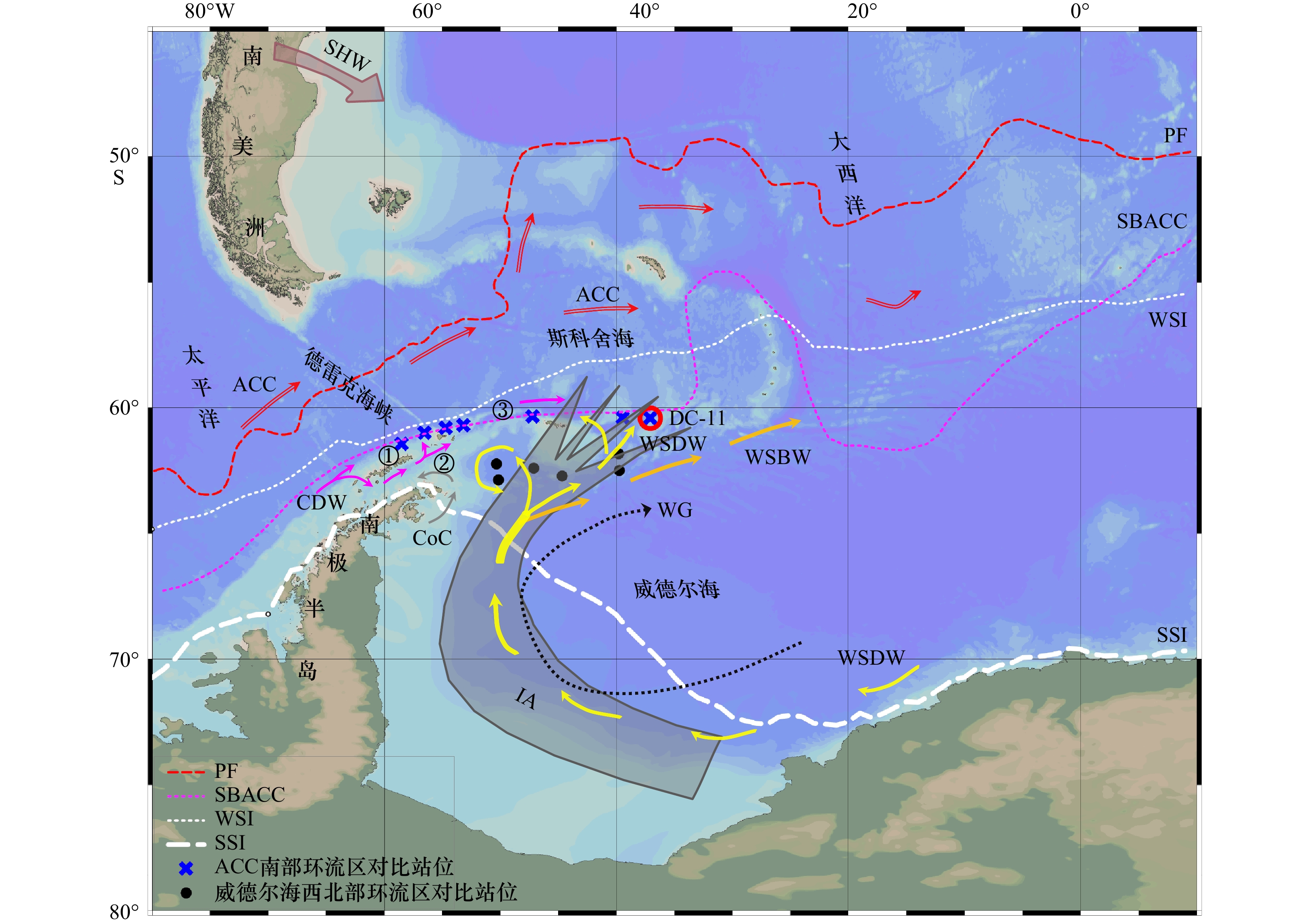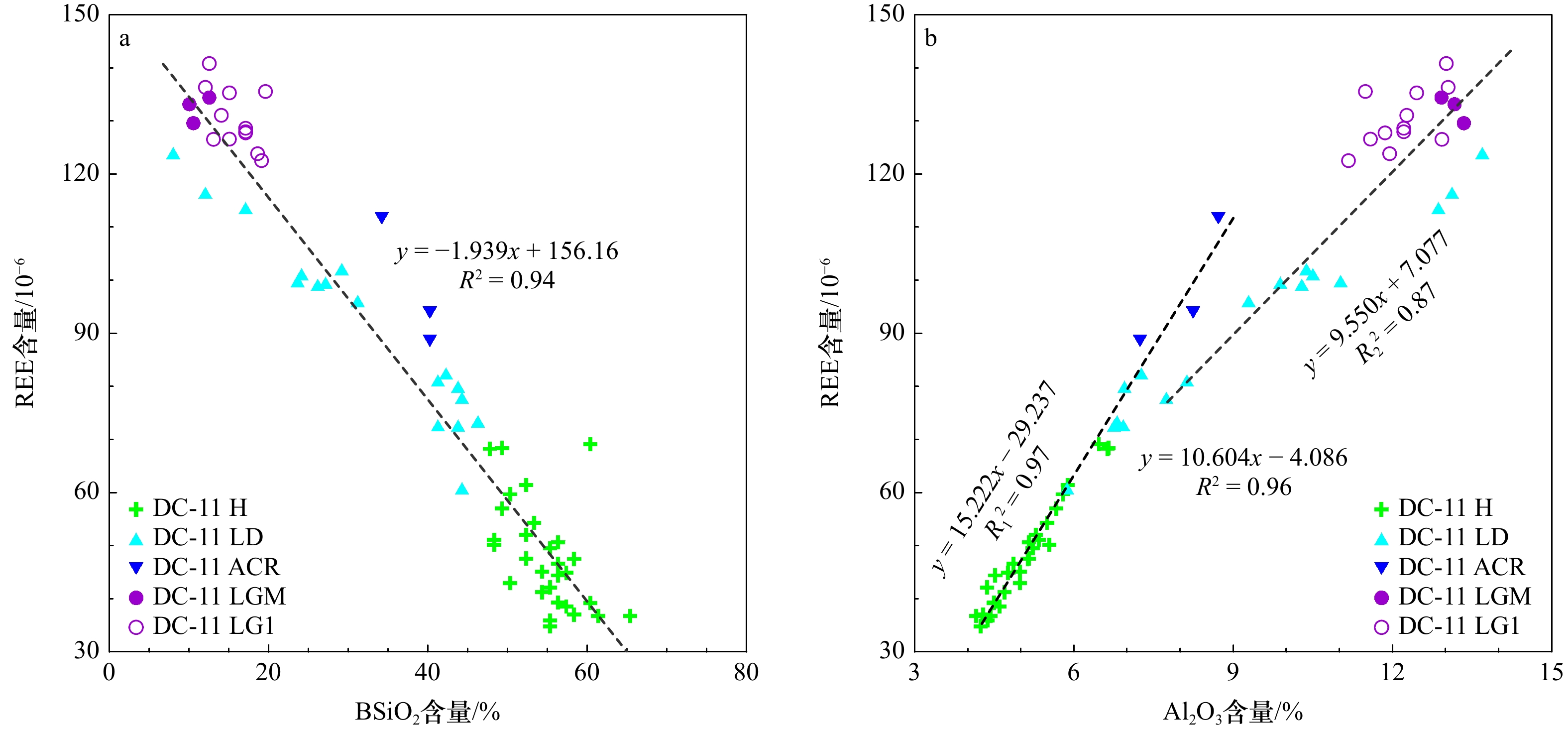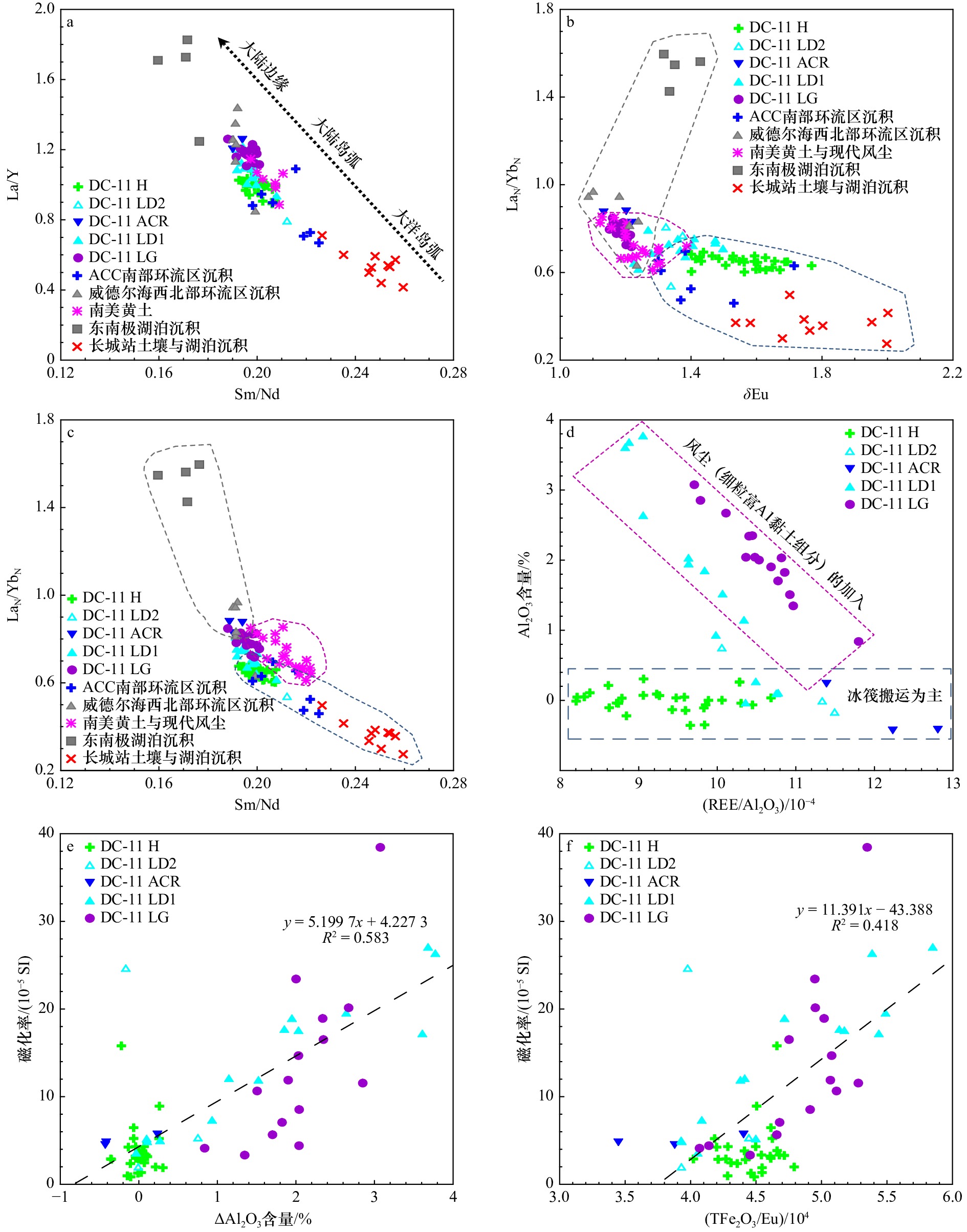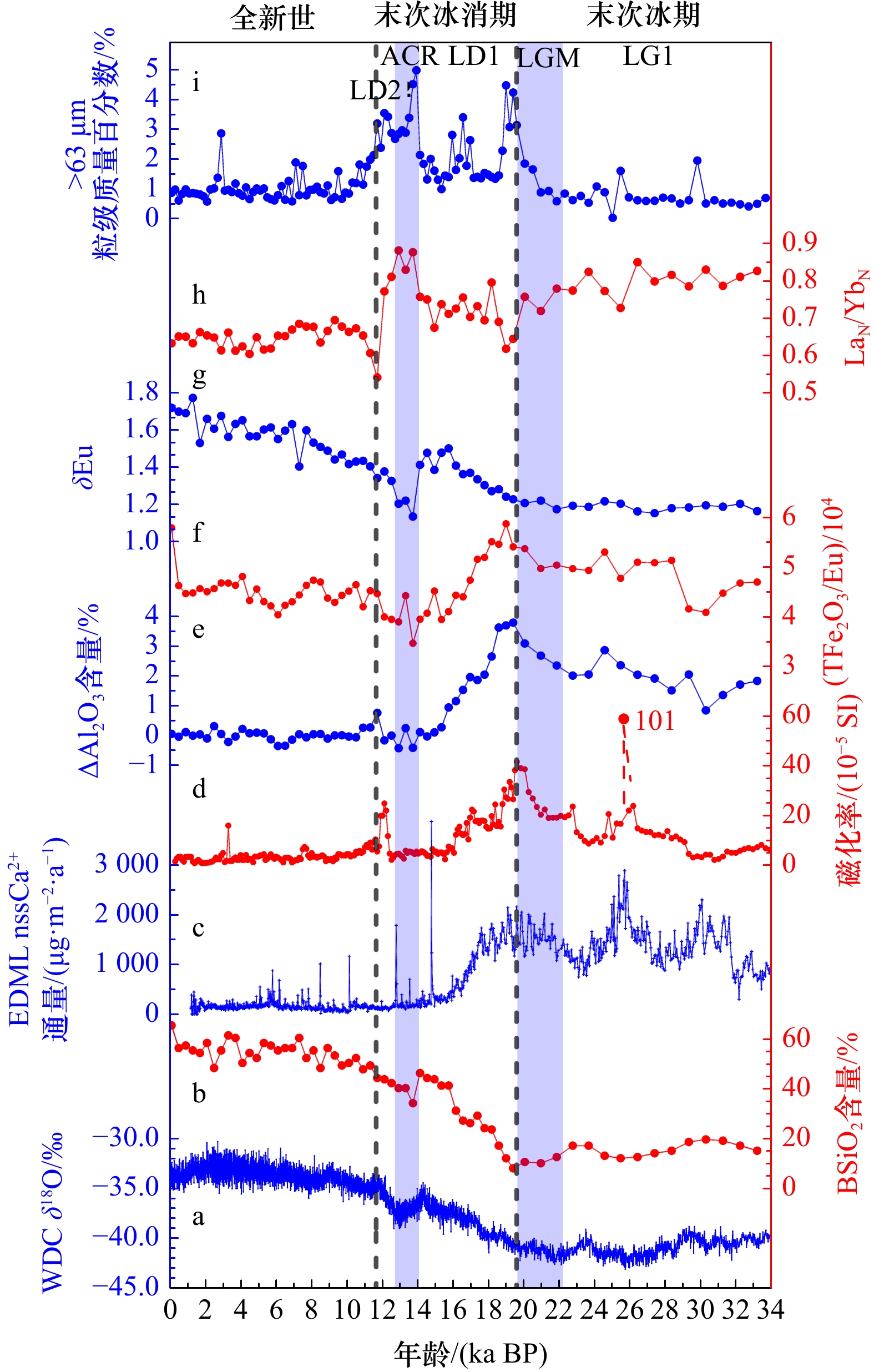Sediment provenances and environmental changes in the southeastern Scotia Sea, Antarctica, since the Last Glaciation
-
摘要: 本文通过南极斯科舍海东南部海域DC-11岩芯稀土元素(REE)特征及其与生源硅(BSiO2)、磁化率、Al2O3、Fe2O3的耦合关系,深入探讨了34 ka BP以来研究区沉积物的来源及冰山−海流−大气搬运历史。结果表明,DC-11岩芯沉积物REE含量变化与Al2O3相似,主要赋存于陆源碎屑之中,BSiO2对其有明显稀释效应。末次冰期REE含量高,页岩标准化模式平坦,Eu正异常弱,LaN/YbN比值较大,沉积物主要来源于地壳相对较老的威德尔海周边地区,磁化率、ΔAl2O3、TFe2O3/Eu比值证实该时期沉积物中南美风尘物质多。冰消期早期(19.6~14.1 ka BP)气候快速回暖,西风带与海洋锋面南移,南美风尘输入迅速减弱,南极绕极流南部分支增强,导致南设德兰群岛−南极半岛的冰山及沉积物向东搬运至研究区,沉积物Eu正异常明显,LaN/YbN比值小,磁化率、ΔAl2O3、TFe2O3/Eu比值降低。南极冷倒转期(14.1~12.9 ka BP),南极气温明显下降,海洋锋面小幅北移,来自南设德兰群岛−南极半岛沉积物减少,威德尔海沉积物在岩芯中占主导,沉积物Eu正异常弱,LaN/YbN比值接近于1,冰筏碎屑含量高;冰消期晚期(12.9~11.7 ka BP)海洋锋面再次南移,南设德兰群岛−南极半岛海域南极绕极流分量增强,对DC-11岩芯沉积物贡献加大;全新世(11.7~0 ka BP)气候温暖,南设德兰群岛−南极半岛海域南极绕极流分量总体增强,对岩芯沉积物贡献加大,与来自威德尔海的沉积物量大体相当。Abstract: Rare earth elements (REE) and their relationships with biogenic silica (BSiO2), magnetic susceptibility, Al2O3 and Fe2O3 in Core DC-11 were analyzed to reveal sediment provenances and transport history by iceberg-current-atmosphere since 34 ka BP in the southeastern Scotia Sea, Antarctica. Temporal variation of REE is similar to that of Al2O3, indicating they mainly occur in terrigenous detritus and BSiO2 has obvious dilution effect on them. Sediments with high REE concentration, flat shale-normalized pattern, weak positive Eu anomaly, and high LaN/YbN ratio during the last glacial period indicated they are transferred from the Weddell Sea and eroded from the bordering lands with relatively old crust. The increases in magnetic susceptibility, ΔAl2O3, TFe2O3/Eu ratio indicated an enhanced input of dust from South America during this period. In early Deglaciation (19.6−14.1 ka BP), increasing Eu positive anomaly and lower LaN/YbN ratio indicated the southern branch of Antarctic Circumpolar Current (ACC) strengthened and contributed more sediments from the South Shetland Islands and Antarctic Peninsula due to the southward shifts of oceanic fronts, while decreasing magnetic susceptibility, ΔAl2O3, TFe2O3/Eu ratios showed rapid decrease in dust supply from South America. During the Antarctic Cold Reversal period (ACR, 14.1−12.9 ka BP), sediments from the South Shetland Islands and Antarctic Peninsula decreased sharply due to cold condition and weakened ACC branch, the weakest Eu positive anomaly and highest LaN/YbN ratio indicated that the sediments from the Weddell Sea dominated in the core again, and the peak of ice raft debris indicated ice rafting is vital or dominant agent. In the late Deglaciation (12.9−11.7 ka BP), the return of ACC branch to the South Shetland Islands and Antarctic Peninsula contributed more to the sediments in Core DC-11; in Holocene (11.7−0 ka BP), the ACC branch in the area between the South Shetland Islands and Antarctic Peninsula was generally enhanced, and its contribution to core sediments increased to be roughly equivalent to the amount of sediments from the Weddell Sea.
-
Key words:
- Antarctic /
- Scotia Sea /
- rare earth elements /
- sediment provenances /
- environmental changes
-
图 1 斯科舍海地形图及站位、环流分布(据文献[2, 15−19])
SHW(灰色箭头):南半球西风带;PF(红色虚线):极锋;ACC(红色箭头):南极绕极流;CDW(粉红色箭头):绕极深层水;SBACC(粉红色虚线):南极绕极流南边界;WG(黑色虚线箭头):威德尔涡流;WSBW(橘色箭头):威德尔海底层水;WSDW(黄色箭头):威德尔海深层水;WSI(白色细虚线)和SSI(白色粗虚线):南半球冬季和夏季海冰线;IA(灰色条带):冰山通道;CoC(灰色箭头):沿岸流;①南设德兰群岛;②布兰斯菲尔德海峡;③南斯科舍海脊
Fig. 1 Physiographic map of the Scotia Sea showing sample positions and marine circulation (by references [2, 15−19])
SHW (gray arrow): the dominant direction of the Southern Hemisphere Westerlies; PF (red dashed line): the Polar Front; ACC (red arrow): the Antarctic Circumpolar Current; CDW (pink arrow): the Circumpolar Deep Water; SBACC (pink dotted line): the Southern Boundary of the Antarctic Circumpolar Current; WSBW (brown arrow): the Weddell Sea Bottom Water; WSDW (yellow arrow): the Weddell Sea Deep Water; WG (black dotted arrows): the Weddell Gyre; WSI (white fine dotted line) and SSI (white thick dashed line): the austral winter and summer sea ice limits, respectively; IA (gray belt): the iceberg alley; CoC (gray arrow): coastal current; ① South Shetland Islands; ② Bransfield Strait; ③ South Scotia Ridge
图 2 DC-11岩芯稀土元素(REE)含量及特征参数变化
a. 西南极冰芯δ18O记录[25];b. DC-11岩芯REE含量;c. Al2O3含量;d. BSiO2含量;e. LREEN/HREEN;f. δEu
Fig. 2 Concentration and characteristic parameters of rare earth elements (REE) in Core DC-11
a. δ18O from West Antarctica ice core WDC[25]; b. REE content of Core DC-11; c. Al2O3 content; d. BSiO2 content; e. LREEN/HREEN; f. δEu
图 5 DC-11岩芯物源的地球化学判别
DC-11(H, LD2, ACR, LD1, LG)数据来源于本文;ACC南部环流区沉积物数据来源于文献[29];威德尔海西北部环流区沉积物数据来源于文献[29];南美黄土数据来源于文献[32];南美现代风尘数据来源于文献[41];东南极湖泊沉积物数据来源于文献[31];长城站土壤与湖泊沉积物数据来源于文献[29]
Fig. 5 Geochemical discrimination for sediment provenances in Core DC-11
DC-11 (H, LD2, ACR, LD1, LG) data is by this study; data of the sediments along the southern branch of ACC are from reference [29]; data of the sediments along the circulation in the northwestern Weddell Sea are from reference [29]; data of loess in South America are from reference [32]; data of modern dust in South America are from reference [41]; data of lake sediments in East Antarctica are from reference [31]; data of soil and lake sediments near Great Wall Station are from reference [29]
图 6 DC-11岩芯记录与南极冰芯记录的综合对比
a. 西南极冰芯WDC δ18O记录[25];b. DC-11岩芯BSiO2含量;c. 东南极冰芯EDML nssCa2+通量[46]; d. DC-11岩芯磁化率;e. DC-11岩芯ΔAl2O3值;f. DC-11岩芯TFe2O3/Eu比值;g. DC-11岩芯δEu;h. DC-11岩芯LaN/YbN比值;i. DC-11岩芯大于63 μm粒级质量百分数
Fig. 6 Comparison of paleo-records from Core DC-11 and Antarctic ice cores
a. δ18O from West Antarctica ice core WDC[25]; b. BSiO2 contents in Core DC-11; c. nssCa2+ flux from East Antarctica ice core EDML[46]; d. susceptibility of Core DC-11 (hereafter); e. ΔAl2O3; f. TFe2O3/Eu ratios; g. δEu; h. LaN/YbN ratios; i. mass percentage of >63 μm grain size
表 1 DC-11岩芯稀土元素含量、特征值统计与对比(稀土元素含量:×10−6)
Tab. 1 Statistics and comparison for concentrations and characteristic parameters of rare earth elements (REE) in Core DC-11 (REE concentrations: ×10−6)
样品 参数 La Ce Pr Nd Sm Eu Gd Tb Dy Ho Er Tm Yb Lu REE δCe δEu LREEN/
HREENDC-11岩芯
(n= 64)最小值 6.52 14.24 1.62 6.19 1.24 0.43 1.16 0.20 1.22 0.24 0.73 0.11 0.76 0.13 34.81 0.97 1.13 0.73 最大值 27.88 59.68 6.75 25.22 4.97 1.22 4.58 0.74 4.47 0.88 2.59 0.40 2.62 0.41 140.79 1.08 1.77 1.11 变异系数 0.45 0.44 0.45 0.44 0.43 0.32 0.42 0.42 0.41 0.40 0.40 0.39 0.39 0.37 0.44 0.02 0.13 0.09 平均值 15.29 33.83 3.83 14.75 2.91 0.79 2.67 0.44 2.65 0.53 1.52 0.24 1.56 0.25 81.24 1.02 1.40 0.90 DC-11岩芯
分段平均值H (n= 29) 8.82 19.81 2.24 8.70 1.74 0.55 1.62 0.27 1.65 0.33 0.97 0.15 1.01 0.17 48.01 1.03 1.56 0.84 LD2 (n= 3) 14.86 32.66 3.83 14.85 2.96 0.81 2.70 0.45 2.73 0.55 1.57 0.25 1.58 0.26 80.06 1.00 1.35 0.90 ACR (n= 3) 18.98 41.19 4.76 18.18 3.48 0.81 3.04 0.48 2.87 0.56 1.59 0.25 1.63 0.26 98.08 1.00 1.18 1.08 LD1 (n= 14) 17.47 38.89 4.40 17.10 3.38 0.93 3.14 0.51 3.13 0.62 1.77 0.28 1.83 0.29 93.75 1.02 1.36 0.91 LGM (n= 3) 25.17 55.10 6.27 23.97 4.77 1.16 4.34 0.71 4.33 0.85 2.46 0.38 2.48 0.40 132.38 1.01 1.20 0.94 LG1 (n= 12) 25.09 54.92 6.19 23.42 4.57 1.09 4.12 0.67 4.02 0.79 2.29 0.36 2.32 0.37 130.23 1.02 1.18 1.00 布兰斯菲尔德海峡
表层沉积物 (n= 4)[26]16.42 36.00 4.92 20.70 4.89 1.27 5.24 0.80 5.12 1.08 3.07 0.41 3.14 0.43 103.49 0.93 1.17 0.61 澳大利亚后太古代页岩[24] 38.20 79.58 8.83 33.90 5.55 1.08 4.65 0.78 4.68 0.99 2.84 0.41 2.82 0.44 184.75 1.00 1.00 南大西洋巴西
海盆黏土(n= 7)[27]48.53 150.71 12.65 46.37 10.18 2.35 9.78 1.32 8.20 1.54 4.25 0.59 3.99 0.58 301.06 1.42 1.11 1.32 南印度洋硅藻[28] 5.77 8.21 6.71 1.56 0.404 1.78 1.69 0.998 0.859 27.98 ACC南部环流区
沉积(n=7)[29]15.14 32.14 4.02 16.23 3.48 0.98 3.11 0.55 3.39 0.67 1.96 0.31 1.96 0.32 84.25 0.96 1.43 0.62 威德尔海西北部
环流区沉积(n=6)[29]28.67 61.24 7.18 26.99 5.18 1.20 4.55 0.74 4.43 0.84 2.43 0.39 2.44 0.39 146.69 0.98 1.18 0.88 铁锰氧化物[30] 161 826 36.7 152 32.7 8.06 39.2 6.2 32.9 6.12 16.6 2.53 15.4 2.22 1337.63 2.48 1.06 1.01 大西洋沉积有机质[30] 19.10 49.00 5.35 20.80 4.09 0.85 3.45 0.48 2.64 0.49 1.30 − 1.11 0.15 108.81 1.12 1.06 南设德兰群岛长城站
土壤/湖泊沉积物(n= 10)[29]8.74 21.24 2.95 13.40 3.31 1.12 2.82 0.52 3.25 0.63 1.80 0.28 1.78 0.29 62.13 0.97 1.78 0.57 东南极湖泊沉积(n= 4)[31] 34.60 77.15 7.75 31.35 5.31 1.33 4.02 0.66 3.98 0.66 2.16 0.31 1.67 0.26 171.21 1.08 1.36 1.65 巴塔哥尼亚黄土(n= 7)[32] 23.87 49.34 6.50 23.34 4.78 1.12 4.20 0.64 3.70 0.76 2.09 0.34 2.19 0.32 123.20 0.91 1.18 1.05 -
[1] Pudsey C J, Howe J A. Quaternary history of the Antarctic Circumpolar Current: evidence from the Scotia Sea[J]. Marine Geology, 1998, 148(1/2): 83−112. [2] Maldonado A, Barnolas A, Bohoyo F, et al. Contourite deposits in the central Scotia Sea: the importance of the Antarctic Circumpolar Current and the Weddell Gyre flows[J]. Palaeogeography, Palaeoclimatology, Palaeoecology, 2003, 198(1/2): 187−221. [3] Maldonado A, Bohoyo F, Galindo-Zaldívar J, et al. Ocean basins near the Scotia–Antarctic plate boundary: influence of tectonics and paleoceanography on the Cenozoic deposits[J]. Marine Geophysical Researches, 2006, 27(2): 83−107. doi: 10.1007/s11001-006-9003-4 [4] Eagles G, Livermore R, Morris P. Small basins in the Scotia Sea: the Eocene Drake Passage gateway[J]. Earth and Planetary Science Letters, 2006, 242(3/4): 343−353. [5] Mccave I N, Crowhurst S J, Kuhn G, et al. Minimal change in Antarctic Circumpolar Current flow speed between the last glacial and Holocene[J]. Nature Geoscience, 2014, 7(2): 113−116. doi: 10.1038/ngeo2037 [6] Diekmann B, Kuhn G, Rachold V, et al. Terrigenous sediment supply in the Scotia Sea (Southern Ocean): response to Late Quaternary ice dynamics in Patagonia and on the Antarctic Peninsula[J]. Palaeogeography, Palaeoclimatology, Palaeoecology, 2000, 162(3/4): 357−387. [7] Cofaigh C Ó, Dowdeswell J A, Pudsey C J. Late quaternary iceberg rafting along the Antarctic Peninsula continental rise and in the weddell and scotia seas[J]. Quaternary Research, 2001, 56(3): 308−321. doi: 10.1006/qres.2001.2267 [8] Pérez L F, Martos Y M, García M, et al. Miocene to present oceanographic variability in the Scotia Sea and Antarctic ice sheets dynamics: insight from revised seismic-stratigraphy following IODP Expedition 382[J]. Earth and Planetary Science Letters, 2021, 553: 116657. doi: 10.1016/j.jpgl.2020.116657 [9] Pugh R S, McCave I N, Hillenbrand C D, et al. Circum-Antarctic age modelling of Quaternary marine cores under the Antarctic Circumpolar Current: ice-core dust–magnetic correlation[J]. Earth and Planetary Science Letters, 2009, 284(1/2): 113−123. [10] Weber M E, Kuhn G, Sprenk D, et al. Dust transport from Patagonia to Antarctica—A new stratigraphic approach from the Scotia Sea and its implications for the last glacial cycle[J]. Quaternary Science Reviews, 2012, 36: 177−188. doi: 10.1016/j.quascirev.2012.01.016 [11] Xiao Wenshen, Esper O, Gersonde R. Last Glacial-Holocene climate variability in the Atlantic sector of the Southern Ocean[J]. Quaternary Science Reviews, 2016, 135: 115−137. doi: 10.1016/j.quascirev.2016.01.023 [12] Xiao Wenshen, Frederichs T, Gersonde R, et al. Constraining the dating of late Quaternary marine sediment records from the Scotia Sea (Southern Ocean)[J]. Quaternary Geochronology, 2016, 31: 97−118. doi: 10.1016/j.quageo.2015.11.003 [13] Weber M E, Bailey I, Hemming S R, et al. Antiphased dust deposition and productivity in the Antarctic Zone over 1.5 million years[J]. Nature Communications, 2022, 13(1): 2044. doi: 10.1038/s41467-022-29642-5 [14] Shin J Y, Kim S, Zhao Xiang, et al. Particle-size dependent magnetic properties of Scotia Sea sediments since the Last Glacial Maximum: glacial ice-sheet discharge controlling magnetic proxies[J]. Palaeogeography, Palaeoclimatology, Palaeoecology, 2020, 557: 109906. doi: 10.1016/j.palaeo.2020.109906 [15] Pérez L F, Lodolo E, Maldonado A, et al. Tectonic development, sedimentation and paleoceanography of the Scan Basin (southern Scotia Sea, Antarctica)[J]. Global and Planetary Change, 2014, 123: 344−358. doi: 10.1016/j.gloplacha.2014.06.007 [16] Orsi A H, Johnson G C, Bullister J L. Circulation, mixing, and production of Antarctic Bottom Water[J]. Progress in Oceanography, 1999, 43(1): 55−109. doi: 10.1016/S0079-6611(99)00004-X [17] Shevenell A E, Ingalls A E, Domack E W, et al. Holocene Southern Ocean surface temperature variability west of the Antarctic Peninsula[J]. Nature, 2011, 470(7333): 250−254. doi: 10.1038/nature09751 [18] Palmer M, Gomis D, del Mar Flexas M, et al. Water mass pathways and transports over the South Scotia Ridge west of 50°W[J]. Deep-Sea Research Part I: Oceanographic Research Papers, 2012, 59: 8−24. doi: 10.1016/j.dsr.2011.10.005 [19] Jiang Mingshun, Charette M A, Measures C I, et al. Seasonal cycle of circulation in the Antarctic Peninsula and the off-shelf transport of shelf waters into southern Drake Passage and Scotia Sea[J]. Deep-Sea Research Part II: Topical Studies in Oceanography, 2013, 90: 15−30. doi: 10.1016/j.dsr2.2013.02.029 [20] Holm-Hansen O, Naganobu M, Kawaguchi S, et al. Factors influencing the distribution, biomass, and productivity of phytoplankton in the Scotia Sea and adjoining waters[J]. Deep-Sea Research Part II: Topical Studies in Oceanography, 2004, 51(12/13): 1333−1350. [21] Korb R E, Whitehouse M J, Ward P, et al. Regional and seasonal differences in microplankton biomass, productivity, and structure across the Scotia Sea: implications for the export of biogenic carbon[J]. Deep-Sea Research Part II: Topical Studies in Oceanography, 2012, 59−60: 67−77. doi: 10.1016/j.dsr2.2011.06.006 [22] Weber M E, Clark P U, Kuhn G, et al. Millennial-scale variability in Antarctic ice-sheet discharge during the last deglaciation[J]. Nature, 2014, 510(7503): 134−138. doi: 10.1038/nature13397 [23] 杨春丽, 陈志华, 肖文申, 等. 3.4万年以来南极斯科舍海古生产力演变及其环境制约[J]. 海洋学报, 2021, 43(3): 116−125.Yang Chunli, Chen Zhihua, Xiao Wenshen, et al. Paleoproductivity and its environmental constraints in the Scotia Sea, Antarctica since 34 ka BP[J]. Haiyang Xuebao, 2021, 43(3): 116−125. [24] Taylor S R, McLennan S M. The Continental Crust: its Composition and Evolution[M]. Oxford: Blackwell, 1985: 1−312. [25] WAIS Divide Project Members. Onset of deglacial warming in West Antarctica driven by local orbital forcing[J]. Nature, 2013, 500(7463): 440−444. doi: 10.1038/nature12376 [26] Lee J I, Park B K, Jwa Y J, et al. Geochemical characteristics and the provenance of sediments in the Bransfield Strait, West Antarctica[J]. Marine Geology, 2005, 219(2/3): 81−98. [27] Dubinin A V, Rimskaya-Korsakova M N. Geochemistry of rare earth elements in bottom sediments of the Brazil Basin, Atlantic Ocean[J]. Lithology and Mineral Resources, 2011, 46(1): 1−16. doi: 10.1134/S0024490211010032 [28] Elderfield H, Hawkesworth C J, Greaves M J, et al. Rare earth element geochemistry of oceanic ferromanganese nodules and associated sediments[J]. Geochimica et Cosmochimica Acta, 1981, 45(4): 513−528. doi: 10.1016/0016-7037(81)90184-8 [29] 陈志华, 黄元辉, 唐正, 等. 南极半岛东北部海域表层沉积物稀土元素特征及物源指示意义[J]. 海洋地质与第四纪地质, 2015, 35(3): 145−155.Chen Zhihua, Huang Yuanhui, Tang Zheng, et al. Rare earth elements in the offshore surface sediments of the northeastern Antarctic Peninsula and their implications for provenance[J]. Marine Geology & Quaternary Geology, 2015, 35(3): 145−155. [30] Freslon N, Bayon G, Toucanne S, et al. Rare earth elements and neodymium isotopes in sedimentary organic matter[J]. Geochimica et Cosmochimica Acta, 2014, 140: 177−198. doi: 10.1016/j.gca.2014.05.016 [31] Levitan M A, Girin Y P, Luksha V L, et al. Modern sedimentation system of Lake Untersee, East Antarctica[J]. Geochemistry International, 2011, 49(5): 459−481. doi: 10.1134/S0016702911050077 [32] Gallet S, Jahn B, Van Vliet Lanoë B, et al. Loess geochemistry and its implications for particle origin and composition of the upper continental crust[J]. Earth and Planetary Science Letters, 1998, 156(3/4): 157−172. [33] Piper D Z. Rare earth elements in ferromanganese nodules and other marine phases[J]. Geochimica et Cosmochimica Acta, 1974, 38(7): 1007−1022. doi: 10.1016/0016-7037(74)90002-7 [34] 孟妍, 伏美燕. 去除有机质前后海底沉积物对稀土元素吸附能力的变化研究[J]. 热带海洋学报, 2006, 25(4): 20−24.Meng Yan, Fu Meiyan. Capacity change of marine sediments with and without organic matter for absorption of rare earth elements[J]. Journal of Tropical Oceanography, 2006, 25(4): 20−24. [35] Pourret O, Davranche M, Gruau G, et al. New insights into cerium anomalies in organic-rich alkaline waters[J]. Chemical Geology, 2008, 251(1/4): 120−127. [36] 王中刚, 于学元, 赵振华, 等. 稀土元素地球化学[M]. 北京: 科学出版社, 1989.Wang Zhonggang, Yu Xueyuan, Zhao Zhenhua, et al. REE Geochemistry[M]. Beijing: Science Press, 1989. [37] Bhatia M R, Crook K A W. Trace element characteristics of graywackes and tectonic setting discrimination of sedimentary basins[J]. Contributions to Mineralogy and Petrology, 1986, 92(2): 181−193. doi: 10.1007/BF00375292 [38] 郑光高, 刘晓春, 赵越. 南极半岛中新生代构造岩浆演化及与南美巴塔哥尼亚对比[J]. 矿物岩石地球化学通报, 2015, 34(6): 1090−1102.Zheng Guanggao, Liu Xiaochun, Zhao Yue. Mesozoic-Cenozoic tectonomagmatic evolution of the Antarctic peninsula and its correlation with Patagonia of southernmost South America[J]. Bulletin of Mineralogy, Petrology and Geochemistry, 2015, 34(6): 1090−1102. [39] 郑光高, 刘晓春, 赵越, 等. 西南极岩浆作用及构造演化[J]. 地质力学学报, 2021, 27(5): 821−834.Zheng Guanggao, Liu Xiaochun, Zhao Yue, et al. Magmatism and tectonic evolution of West Antarctica[J]. Journal of Geomechanics, 2021, 27(5): 821−834. [40] Diekmann B, Kuhn G. Provenance and dispersal of glacial-marine surface sediments in the Weddell Sea and adjoining areas, Antarctica: ice-rafting versus current transport[J]. Marine Geology, 1999, 158(1/4): 209−231. [41] Gaiero D M, Depetris P J, Probst J L, et al. The signature of river- and wind-borne materials exported from Patagonia to the southern latitudes: a view from REEs and implications for paleoclimatic interpretations[J]. Earth and Planetary Science Letters, 2004, 219(3/4): 357−376. [42] Walter H J, Hegner E, Diekmann B, et al. Provenance and transport of terrigenous sediment in the South Atlantic Ocean and their relations to glacial and interglacial cycles: Nd and Sr isotopic evidence[J]. Geochimica et Cosmochimica Acta, 2000, 64(22): 3813−3827. doi: 10.1016/S0016-7037(00)00476-2 [43] Gaiero D M, Probst J L, Depetris P J, et al. Iron and other transition metals in Patagonian riverborne and windborne materials: geochemical control and transport to the southern South Atlantic Ocean[J]. Geochimica et Cosmochimica Acta, 2003, 67(19): 3603−3623. doi: 10.1016/S0016-7037(03)00211-4 [44] Martínez-Garcia A, Rosell-Melé A, Jaccard S L, et al. Southern Ocean dust- climate coupling over the past four million years[J]. Nature, 2011, 476(7360): 312−315. doi: 10.1038/nature10310 [45] Wolff E W, Fischer H, Fundel F, et al. Southern Ocean sea-ice extent, productivity and iron flux over the past eight glacial cycles[J]. Nature, 2006, 440(7083): 491−496. doi: 10.1038/nature04614 [46] Fischer H, Fundel F, Ruth U, et al. Reconstruction of millennial changes in dust emission, transport and regional sea ice coverage using the deep EPICA ice cores from the Atlantic and Indian Ocean sector of Antarctica[J]. Earth and Planetary Science Letters, 2007, 260(1/2): 340−354. [47] 赵一阳, 鄢明才. 中国浅海沉积物地球化学[M]. 北京: 科学出版社, 1994: 130−150.Zhao Yiyang, Yan Mingcai. Geochemistry of Sediments of the China Shelf Sea[M]. Beijing: Science Press, 1994: 130−150. [48] Diekmann B. Sedimentary patterns in the late Quaternary Southern Ocean[J]. Deep-Sea Research Part II: Topical Studies in Oceanography, 2007, 54(21/22): 2350−2366. [49] Wang Haozhuang, Chen Zhihua, Wang Kunshan, et al. Characteristics of heavy minerals and grain size of surface sediments on the continental shelf of Prydz Bay: implications for sediment provenance[J]. Antarctic Science, 2016, 28(2): 103−114. doi: 10.1017/S0954102015000498 [50] Garçon M, Chauvel C, France-Lanord C, et al. Which minerals control the Nd–Hf–Sr–Pb isotopic compositions of river sediments?[J]. Chemical Geology, 2014, 364: 42−55. doi: 10.1016/j.chemgeo.2013.11.018 [51] Baccolo G, Delmonte B, Albani S, et al. Regionalization of the atmospheric dust cycle on the periphery of the East Antarctic ice sheet since the Last Glacial Maximum[J]. Geochemistry, Geophysics, Geosystems, 2018, 19(9): 3540−3554. doi: 10.1029/2018GC007658 [52] Kim S, Yoo K C, Lee J I, et al. Relationship between magnetic susceptibility and sediment grain size since the last glacial period in the Southern Ocean off the northern Antarctic Peninsula-Linkages between the cryosphere and atmospheric circulation[J]. Palaeogeography, Palaeoclimatology, Palaeoecology, 2018, 505: 359−370. doi: 10.1016/j.palaeo.2018.06.016 [53] Liu Qingsong, Torrent J, Morrás H, et al. Superparamagnetism of two modern soils from the northeastern Pampean region, Argentina and its paleoclimatic indications[J]. Geophysical Journal International, 2010, 183(2): 695−705. doi: 10.1111/j.1365-246X.2010.04786.x [54] Anderson J B, Shipp S S, Lowe A L, et al. The Antarctic Ice Sheet during the Last Glacial Maximum and its subsequent retreat history: a review[J]. Quaternary Science Reviews, 2002, 21(1/3): 49−70. [55] Cofaigh C Ó, Davies B J, Livingstone S J, et al. Reconstruction of ice-sheet changes in the Antarctic Peninsula since the Last Glacial Maximum[J]. Quaternary Science Reviews, 2014, 100: 87−110. doi: 10.1016/j.quascirev.2014.06.023 [56] Reinardy B T I, Pudsey C J, Hillenbrand C D, et al. Contrasting sources for glacial and interglacial shelf sediments used to interpret changing ice flow directions in the Larsen Basin, Northern Antarctic Peninsula[J]. Marine Geology, 2009, 266(1/4): 156−171. [57] Kohfeld K E, Graham R M, de Boer A M, et al. Southern Hemisphere westerly wind changes during the Last Glacial Maximum: paleo-data synthesis[J]. Quaternary Science Reviews, 2013, 68: 76−95. doi: 10.1016/j.quascirev.2013.01.017 [58] Sugden D E, McCulloch R D, Bory A J M, et al. Influence of Patagonian glaciers on Antarctic dust deposition during the last glacial period[J]. Nature Geoscience, 2009, 2(4): 281−285. doi: 10.1038/ngeo474 [59] Toggweiler J R, Russell J. Ocean circulation in a warming climate[J]. Nature, 2008, 451(7176): 286−288. doi: 10.1038/nature06590 [60] Heroy D C, Anderson J B. Radiocarbon constraints on Antarctic Peninsula ice sheet retreat following the Last Glacial Maximum (LGM)[J]. Quaternary Science Reviews, 2007, 26(25/28): 3286−3297. [61] Graham A G C, Smith J A. Palaeoglaciology of the Alexander Island ice cap, western Antarctic Peninsula, reconstructed from marine geophysical and core data[J]. Quaternary Science Reviews, 2012, 35: 63−81. doi: 10.1016/j.quascirev.2012.01.008 [62] Mendelová M, Hein A S, Rodés A, et al. Glacier expansion in central Patagonia during the Antarctic Cold Reversal followed by retreat and stabilisation during the Younger Dryas[J]. Quaternary Science Reviews, 2020, 227: 106047. doi: 10.1016/j.quascirev.2019.106047 [63] Lamping N, Müller J, Esper O, et al. Highly branched isoprenoids reveal onset of deglaciation followed by dynamic sea-ice conditions in the western Amundsen Sea, Antarctica[J]. Quaternary Science Reviews, 2020, 228: 106103. doi: 10.1016/j.quascirev.2019.106103 -





 下载:
下载:





